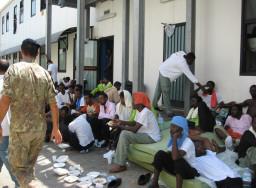Around 230 expulsion orders have been issued for Tunisian immigrants currently at the migrant centre on Lampedusa after Interior Minister Roberto Maroni inked a deal with the Tunisian government earlier this week.
The Tunisians will be sent home in accordance with a new government pledge to repatriate all illegal immigrants who arrive on the shores of the southern Italian island in a bid to stem the flow of migrants from the north African coast.
Three judges are in the process of validating the expulsion orders, which, once approved, must be carried out within 60 days.
Officials estimate there are currently 1,000 Tunisians at the southern Italian island's overcrowded migrant centre (CPA), but the identification process has yet to be completed for around half of them.
The interior ministry has meanwhile announced that the CPA will temporarily function as an identification and expulsion centre (CIE) for legal reasons, since immigrants cannot be served with expulsion papers at CPAs.
A former naval base in an isolated area of the island, previously earmarked for the new CIE, will instead function as a CPA.
Lampedusa Mayor Bernardino De Rubeis and the island's residents have been protesting the creation of a CIE on the island, which they say will damage tourism and turn it into ''a Mediterranean Alcatraz''.
De Rubeis on Thursday expressed concerns over the use of the naval base, which he says is not sufficiently equipped with drainage systems and could end up polluting the nearby beach.
Last week the United Nations refugee agency UNHCR slammed Italy over chronic overcrowding at the 850-bed CPA, which at one point held more than 1,800 immigrants.
There are now around 1,150 people at the centre, after most recognised asylum seekers were transferred to a centre on the mainland and 140 immigrants (including 96 asylum seekers) were moved to the naval base.
According to United Nations Refugee Agency figures, some 36,000 people landed on Italian coasts last year - a 75% increase compared to 2007 figures.
The statistics reveal that Italy took more than half of the 67,000 immigrants who arrived by sea in Europe as a whole.
The majority of Italy's illegal immigrants - around 31,000 - arrived on the island of Lampedusa, which is closer to the north African coast than the Italian mainland.








